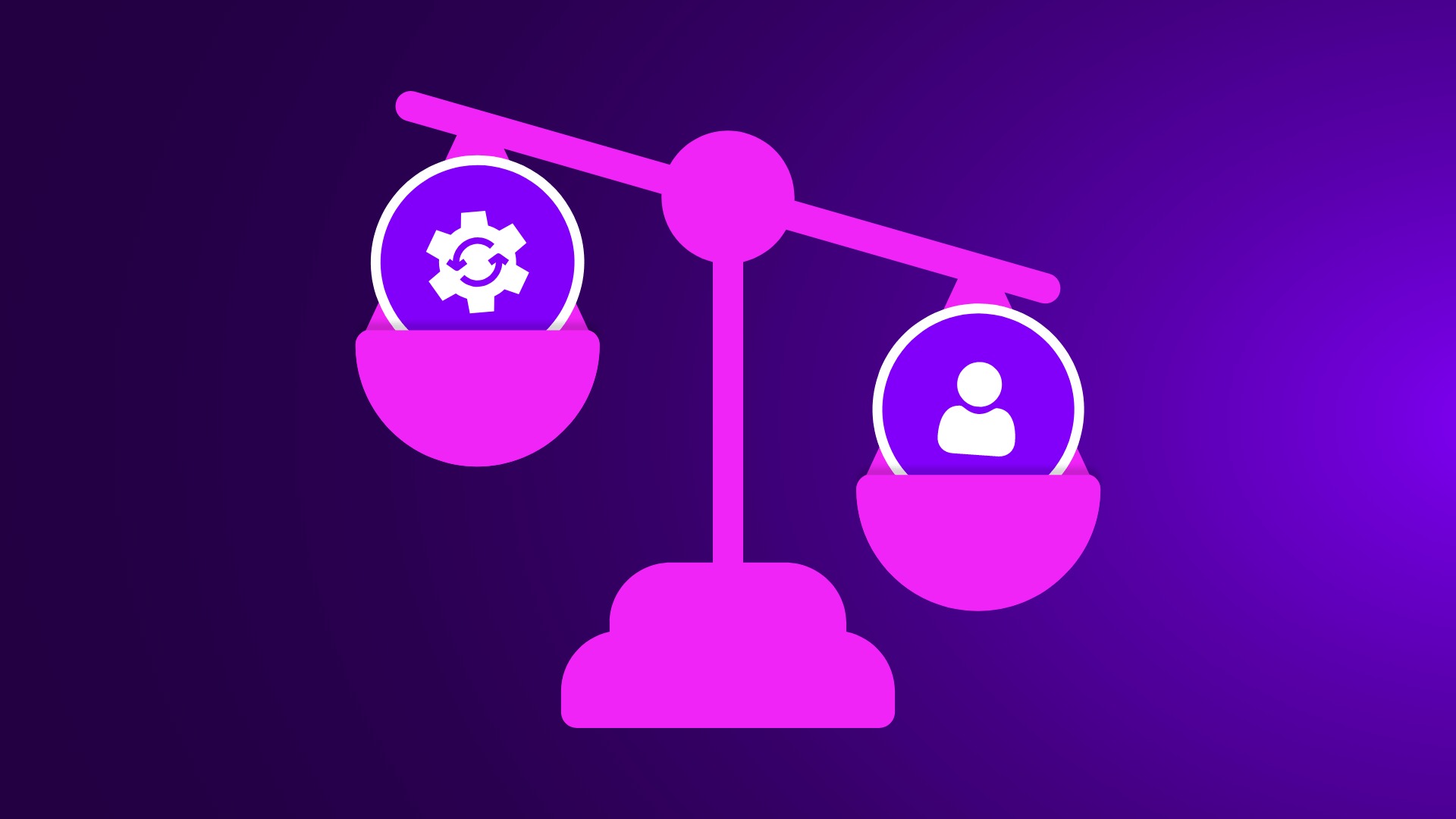AI and Automation in Social Media Management: Balancing Efficiency with Authenticity
Artificial intelligence is transforming how brands engage with audiences on social media. Tasks like scheduling posts, analyzing engagement, and responding to messages now take seconds through automation, giving marketers more time for creativity and strategy.
| Did you know? More than 500 million posts are made daily across social platforms a volume impossible for any human team to monitor manually without AI assistance. This highlights the importance of expert guidance in managing your social media account. |
However, as algorithms manage more interactions, maintaining genuine human connection becomes harder. Since authenticity drives engagement, audiences quickly sense when communication feels robotic.
This article explores AI and automation in social media management, the balance between efficiency and human touch, and the best ways for brands to integrate automation without losing authenticity. Readers will gain insight into the technologies behind automation, its impact on engagement, and practical strategies to harmonize AI precision with real human emotion.
Understanding AI and Automation in Social Media Management
Before diving into strategies and challenges, it’s essential to understand what AI and automation truly mean. These technologies don’t just simplify posting schedules they redefine how brands analyze audiences, predict behaviors, and deliver personalized engagement at scale.
What Does AI Mean in the Context of Social Media?
AI in social media marketing refers to the use of machine learning, predictive analytics, and natural language processing to automate and optimize marketing activities. From analyzing engagement metrics to generating captions, AI systems interpret massive volumes of social data to uncover insights that humans might overlook.
Through AI-driven content intelligence, marketers can:
- Identify high-performing post types and formats
- Predict the best times for audience engagement
- Track sentiment to understand public perception
- Automate repetitive actions like replies or tagging
These intelligent tools help brands create data-backed decisions that enhance campaign performance while saving valuable time.
| Did you know? Over 70% of global brands report that their top-performing social posts were either optimized or co-created using AI insights. |
How Do AI and Automation Work Together to Support Marketers?
When used strategically, AI and automation complement each other. AI acts as the “brain,” analyzing behaviors, predicting outcomes, and suggesting actions. Automation serves as the “hands,” executing these insights across campaigns and platforms.
Together, they allow brands to:
- Scale content distribution across multiple networks
- Personalize communication using data-driven insights
- Maintain real-time responsiveness with minimal manual effort
This synergy ensures that marketers don’t just work faster but also smarter, focusing their energy on storytelling and strategy rather than repetitive operations.
Popular tools that support these AI capabilities include:
- ChatGPT and Jasper for intelligent content and caption generation
- Hootsuite and Buffer for AI-assisted scheduling and publishing
- Lately AI for content repurposing using audience behavior data
- Sprout Social and Talkwalker for analytics, sentiment tracking, and predictive insights
These intelligent tools help brands make data-backed decisions that enhance campaign performance while saving valuable time and maintaining consistent engagement.
The Efficiency Edge: How AI Enhances Social Media Performance
Management of your social media account has evolved from manual scheduling to a precision-driven ecosystem where AI and automation amplify productivity. For marketers juggling multiple platforms and audiences, efficiency isn’t just about saving time it’s about making every interaction count. AI tools now empower teams to plan, analyze, and execute strategies at a scale previously impossible through human effort alone.
How Does Automated Scheduling Improve Consistency and Timing?
Consistency remains one of the most critical factors in maintaining online visibility. Automated scheduling tools help ensure posts are published at the right time, across multiple channels, even when marketing teams aren’t online.
By analyzing engagement data, AI-driven scheduling systems determine:
- The most effective posting hours for each audience segment
- The frequency that optimizes impressions without oversaturation
- Seasonal or time-sensitive patterns that affect reach
Platforms like Buffer, Hootsuite, and Sprout Social use predictive analytics to suggest optimal posting windows, creating a steady flow of content that maximizes exposure and engagement. This not only enhances efficiency but also maintains brand reliability in the audience’s feed.
How Can Data-Driven Insights Improve Campaign Decisions?
Beyond scheduling, the real power of AI in marketing lies in data-driven decision-making. Advanced analytics tools process billions of engagement signals to identify which types of content perform best and why.
AI enables marketers to:
- Track user behavior patterns across platforms.
- Compare performance metrics between campaigns.
- Predict future trends based on historical data.
For instance, AI dashboards from Sprout Social Insights or Later Analytics visualize which formats such as short videos, carousels, or stories drive higher engagement rates.
How Does Real-Time Monitoring Strengthen Brand Performance?
Reputation management on social media requires rapid awareness. AI-powered monitoring systems continuously track brand mentions, sentiment shifts, and trending topics in real time. This allows teams to address feedback or crises immediately before they escalate.
For example:
- Sentiment analysis tools like Brandwatch and Talkwalker detect tone changes in conversations.
- Social listening software identifies trending hashtags or competitor mentions.
- Automated alerts notify managers when engagement metrics fluctuate unexpectedly.
Such responsiveness enhances customer trust, strengthens community engagement, and prevents negative publicity from spreading.
What Are the Measurable Benefits of Using AI for Efficiency?
Efficiency in social media extends far beyond convenience. The measurable benefits include:
- Reduced operational workload through automated scheduling and reporting
- Faster decision-making backed by AI-generated insights
- Improved content targeting through behavioral analysis
- Higher engagement rates due to consistent and timely posting
Marketers who leverage automation strategically often see a 30–40% increase in campaign productivity compared to manual methods, highlighting AI’s role as a critical driver of digital performance.
| Did you know? The first social media chatbot debuted on Facebook Messenger in 2016 and now there are over 300,000 active bots worldwide. |
The Authenticity Challenge: When Automation Feels Robotic
While AI and automation make social media more efficient, they also risk stripping away what audiences value most genuine human connection. Modern users crave transparency, empathy, and relatability. When posts sound too mechanical or replies appear template-based, engagement often drops. The real challenge lies in finding a balance between the convenience of automation and the authenticity that builds long-term trust.
Why Can Over-Automation Damage Brand Perception?
Excessive automation often makes interactions feel cold or repetitive. Audiences notice when responses lack emotional nuance or when every message follows the same tone and structure. This lack of personalization creates distance between the brand and its followers.
| Research shows that over 70% of consumers prefer authentic interactions over automated ones, especially when resolving concerns or receiving recommendations. |
While AI chatbots can handle FAQs, they cannot replicate the empathy, humor, or contextual understanding that humans bring to conversations.
Brands that rely too heavily on automation risk:
- Losing their unique voice and personality
- Alienating loyal customers who expect genuine engagement
- Triggering audience fatigue from overly polished or generic content
What Are the Ethical Considerations Behind AI-Driven Communication?
As automation becomes more advanced, ethical concerns arise regarding transparency and authenticity. Should audiences be informed when they are interacting with AI? Should brands disclose the use of AI-generated content?
Ethically responsible brands prioritize:
- Transparency: Clarifying when automated tools are used for responses or scheduling
- Authenticity: Avoiding deceptive use of AI-generated posts that mimic human tone
- Data Responsibility: Ensuring user information gathered by automation systems is handled securely and ethically
Maintaining these principles not only strengthens brand integrity but also aligns with growing audience expectations for honesty and accountability online.
Balancing Automation with Authentic Engagement
The most effective brands don’t choose between automation and authenticity they merge them. The real success lies in creating a hybrid strategy where AI handles precision and consistency, while human creativity maintains empathy and emotional resonance. Striking this balance ensures audiences feel connected without sacrificing efficiency or responsiveness.
What Is an AI-Human Collaboration Framework and How Does It Work?
An AI-human collaboration framework defines clear boundaries between automated operations and human-led creativity. It structures workflows to maximize the strength of both.
A practical framework may include:
- AI for Analysis: Use tools like ChatGPT, Lately AI, or Jasper to identify trends and generate initial drafts.
- Human Review for Authenticity: Editors refine tone, adjust messaging, and ensure emotional coherence.
- Automated Deployment: Schedule approved content through systems like Sprout Social or Buffer.
This synergy guarantees that content aligns with brand identity while benefiting from data-backed precision. It helps brands communicate efficiently without appearing robotic or detached.
| Did you know? Automation doesn’t just save time it can cut content-production costs by up to 40% while increasing posting frequency by 5x. |
Why Is Ethical Automation Important in Social Media Strategy?
As automation becomes a norm, maintaining ethical standards ensures long-term trust and credibility. Consumers increasingly value honesty in how brands use AI for interaction and content creation.
Ethical automation involves:
- Transparency: Clearly indicating when a response or message is AI-generated
- Accountability: Ensuring human oversight over automated decisions
- Data Security: Protecting audience data from misuse or over-collection
- Fair Representation: Preventing bias in AI-generated recommendations or posts
Responsible brands use automation to enhance service quality, not to deceive users. This practice not only strengthens authenticity but also aligns with emerging global standards in digital ethics.
Frequently Asked Questions
What Are the Best AI Tools for Social Media Content Creation?
The best AI tools for social media content creation depend on your specific goals whether it’s writing captions, generating visuals, or optimizing engagement.
- Jasper and Copy.ai excel at writing platform-specific posts and ad copy with tone customization.
- Canva Magic Write and Adobe Firefly generate branded visuals, carousel posts, and captions seamlessly.
- Lately AI repurposes long-form content into short, social-ready formats based on audience data.
Each of these platforms integrates natural language generation (NLG) and machine learning to produce on-brand, SEO-aligned content faster while maintaining creativity.
How Can Brands Maintain Authenticity While Using AI and Automation?
Maintaining authenticity requires clear boundaries between automated efficiency and human storytelling. Brands can achieve this by:
- Automating repetitive operations (scheduling, analytics, FAQs) but keeping human oversight in tone and engagement.
- Reviewing AI-generated content for emotion, context, and relatability.
- Personalizing communication using audience data rather than relying on templates.
- Clearly disclosing when automated systems are used in customer interactions.
Authenticity thrives when technology amplifies empathy instead of replacing it. A human-first automation model builds trust and loyalty while still leveraging AI precision.
Is AI Replacing Human Social Media Managers?
No, AI is not replacing social media managers, but it is reshaping their roles. Instead of spending time on repetitive tasks, managers now focus on creative strategy, storytelling, and community building.
AI handles scheduling and analytics, data interpretation, predictive recommendations, and chatbot-based support, while humans manage tone, emotion, and cultural understanding, relationship building, crisis communication, and brand storytelling.
What Trends Will Shape the Future of AI in Social Media Marketing?
The next phase of AI in social media will focus on emotional intelligence, deeper personalization, and transparency. Trends include:
- Emotional AI: Understanding and responding to user sentiment in real time.
- Predictive analytics: Forecasting audience behavior to deliver hyper-relevant content.
- AI-driven storytelling: Combining data with creative context for personalized narratives.
- Ethical automation: Transparent use of AI with data privacy safeguards.
These trends point toward a human-centered AI ecosystem, where technology enhances relationships rather than diminishing them.





